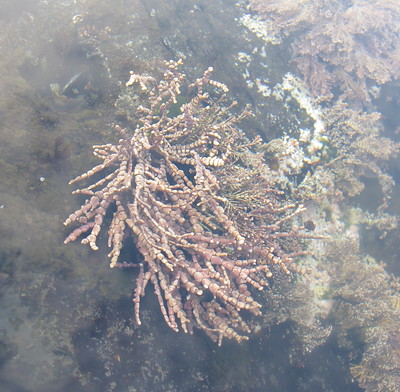Coralline Algae
This seaweed has a stony “shell.”
 Coralline algae collect calcium carbonate from the seawater, building a durable exterior. Although few can eat through or digest the mineralized outsides, densely packed coralline algae offers rich habitat for many tidepool animals. Watch for hermit crabs, snails, tidepool sculpins, and more moving among the branches of this algae.
Coralline algae collect calcium carbonate from the seawater, building a durable exterior. Although few can eat through or digest the mineralized outsides, densely packed coralline algae offers rich habitat for many tidepool animals. Watch for hermit crabs, snails, tidepool sculpins, and more moving among the branches of this algae.
Coralline algae bleaches white when it dies, making it look like even more like bits of coral or bone. Ground up by surf and moving sand, the calcium carbonate in dead algae will be dissolved in seawater and eventually reused—leaving the algae in the tidepools ensures it will be recycled.
Dusty-pink and brittle-looking, coralline algae look a lot like tufts of fine-scale coral. These seaweeds come in three different forms: flat fronds, jointed fingers, and bushy. Most coralline algae are smaller than your outstretched hand, but many of them can thickly carpet tidepools.
A close relative, pink rock crust covers rocks and shells with a bumpy, tough, dusty-pink layer, often with scalloped, bleached edges.
